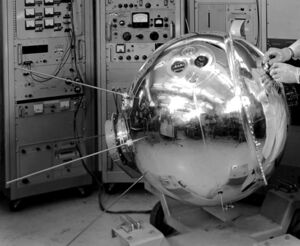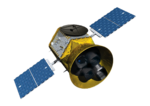Astronomy:Explorer 17
 | |
| Mission type | Earth science |
|---|---|
| Operator | NASA |
| COSPAR ID | 1963-009A |
| SATCAT no. | 564 |
| Mission duration | 1,325 days |
| Spacecraft properties | |
| Manufacturer | GSFC |
| Launch mass | 185 kilograms (408 lb) |
| Start of mission | |
| Launch date | April 3, 1963, 02:00:02 UTC |
| Rocket | Delta B |
| Launch site | Cape Canaveral Air Force Station LC-17A |
| End of mission | |
| Last contact | July 10, 1963 |
| Decay date | 24 November 1966, 09:45:32 UTC |
| Orbital parameters | |
| Reference system | Geocentric |
| Regime | Low Earth |
| Semi-major axis | 6,963.64 kilometers (4,327.01 mi) |
| Eccentricity | 0.04742800071835518 |
| Perigee altitude | 255 kilometers (158 mi) |
| Apogee altitude | 916 kilometers (569 mi) |
| Inclination | 57.60° |
| Period | 96.39 minutes |
| RAAN | 347.3897 degrees |
| Argument of perigee | 125.5060 degrees |
| Mean anomaly | 234.7807 degrees |
| Mean motion | 16.38971129 |
| Epoch | 10 July 1963 |
| Revolution no. | 20364 |
| Instruments | |
| Pressure gauges mass spectrometers electrostatic probes | |
Explorers | |
Explorer 17 (also known as Atmosphere Explorer-A (AE-A) and S6) was a United States satellite, launched at Cape Canaveral Air Force Station from LC-17B on a Delta-B booster, on April 3, 1963, to study the Earth's upper atmosphere. It was the first satellite of five Atmosphere Explorers.
Technical specifications
Explorer 17 was a spin-stabilized sphere 0.95 m in diameter. The spacecraft was vacuum sealed in order to prevent contamination of the local atmosphere. Explorer 17 carried four pressure gauges for the measurement of total neutral particle density, two mass spectrometers for the measurement of certain neutral particle concentrations, and two electrostatic probes for ion concentration and electron temperature measurements. Battery power failed on July 10, 1963. Three of the four pressure gauges and both electrostatic probes operated normally. One spectrometer malfunctioned, and the other operated intermittently.
The successful launch and operating of Explorer 17 allowed scientists for the first time to obtain instantaneous atmospheric density measurements using several independent measuring systems, to measure the atmosphere during a single day under nearly constant local time conditions and geomagnetic activity, and to compare direct measurements of density with those inferred from measurements of perturbations in the satellite period orbit.[1]
The spacecraft decayed from orbit after 1,325 days on November 24, 1966.
References
- ↑ Newton, George P.; Horowitz, Richard; Priester, Wolfgang (July 1965). "Atmospheric Density and Temperature Variations from the Explorer XVII Satellite and a Further Comparison with Satellite Drag". Planetary and Space Science 13 (7): 599–616. doi:10.1016/0032-0633(65)90042-5. Bibcode: 1965P&SS...13..599N.
External links
- NASA's Explorer Missions
- Gunter's Space Page - information on Explorer 17
- Space History Notes


